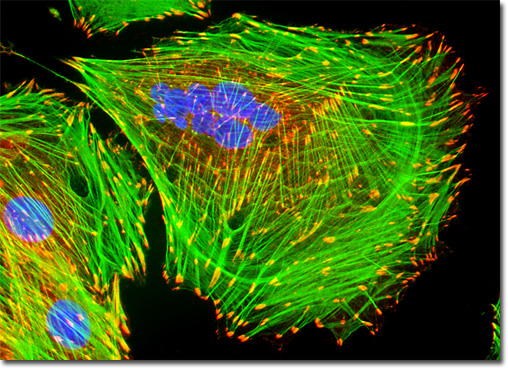Fluorescence Digital Image Gallery
Embryonic Rat Thoracic Aorta Medial Layer Myoblast Cells (A-10)
|
The contraction of smooth muscle is involuntary. Unlike cardiac muscles, however, which also contract involuntarily, the contraction of smooth muscles is slow and forceful, rather than rhythmic and spontaneous. Also, sometimes only a portion of a smooth muscle cell contracts rather than the entire cell, a great contrast to striated muscles, which follow the all-or-none law of contraction. In addition to myosin and actin, a system of intermediate filaments are also involved in the intracellular aspects of smooth muscle contraction. In vascular smooth muscle, these filaments include both vimentin and desmin, though only desmin is present in nonvascular smooth muscle. During contraction, the nucleus of a smooth muscle cell characteristically appears similar to a corkscrew. The culture of A-10 cells illustrated above was immunofluorescently labeled with primary anti-vinculin mouse monoclonal antibodies followed by goat anti-mouse Fab fragments conjugated to Cy3 (red fluorescence emission). Note the prominent staining of the cellular attachment network in the central portion and periphery of these cells. In addition, the specimen was simultaneously stained for DNA with the ultraviolet-absorbing probe DAPI, and for the cytoskeletal filamentous actin network with Alexa Fluor 488 conjugated to phalloidin. Images were recorded in grayscale with a QImaging Retiga Fast-EXi camera system coupled to an Olympus BX-51 microscope equipped with bandpass emission fluorescence filter optical blocks provided by Omega Optical. During the processing stage, individual image channels were pseudocolored with RGB values corresponding to each of the fluorophore emission spectral profiles. |
© 1995-2025 by Michael W. Davidson and The Florida State University. All Rights Reserved. No images, graphics, software, scripts, or applets may be reproduced or used in any manner without permission from the copyright holders. Use of this website means you agree to all of the Legal Terms and Conditions set forth by the owners.
This website is maintained by our
|
